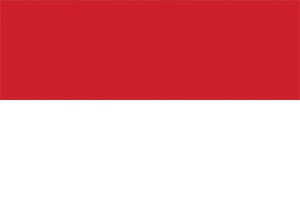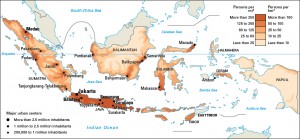Language Monday: Javanese
May 28, 2018
Javanese is a unique language spoken by people from Java, the largest island in Indonesia, a large nation in Southeast Asia. Indonesia is made up of thousands of islands and has an extremely diverse population. Its people belong to about 300 ethnic groups and speak more than 250 languages. The Javanese are the nation’s largest ethnic group, and the Javanese language is Indonesia’s most widely spoken traditional language. More than 84 million people speak Javanese, but it is not the nation’s official language. In the late 1920′s, Indonesian nationalists created a modified form of the Malay language, Bahasa Indonesia, to serve as the official language.

The flag of Indonesia flies over thousands of islands in Southeast Asia. The nation’s largest island, Java, is home to the Javanese language. Credit: © T. Lesia, Shutterstock
Javanese belongs to the Austronesian language family that also includes such Indonesian languages as Balinese (spoken on the island of Bali), Madurese (spoken on the island of Madura), and Sundanese (spoken in western Java). The Austronesian language family spreads far beyond Indonesia, reaching many islands in the Indian and Pacific oceans.

Click to view larger image
This map shows the population density in Indonesia. About 60 percent of all the Indonesian people live on the island of Java, though Java accounts for only about 7 percent of the country’s total area. Credit: WORLD BOOK map
A number of languages have influenced Javanese. Ancient overseas trade with India influenced Java’s early culture and language from at least the A.D. 100’s. Javanese contains many words borrowed from Sanskrit, an ancient language of India. The traditional Javanese alphabet also developed from Indian writing. Ancient India’s two great epic poems, the Mahabharata and the Ramayana, are popular among the Javanese people today. The poems often shape the plots in traditional Javanese theater, known as wayang. Javanese also contains many words borrowed from Arabic. Arab traders brought Islam to Indonesia in the 1400’s and 1500’s, and most Javanese today are Muslims.
Traders from the Netherlands reached Java in the 1590’s. During most of the period from the 1600’s until 1945, the Netherlands ruled Java and the other islands that eventually became Indonesia. During those years, when Indonesia was known as the Dutch East Indies, many Dutch words were absorbed into Javanese. The Dutch period also introduced the Roman alphabet for writing Javanese.
Javanese was Indonesia’s most widely spoken traditional language in the early 1900’s, but Indonesian nationalists wanted a language that could serve as a unifying force for all Indonesians. They believed that making Javanese the national language would give Javanese speakers an unfair advantage. The nationalists developed Bahasa Indonesia, which means language of Indonesia. They based Bahasa Indonesia largely on a dialect called Coastal Malay. People of different ethnic groups had long used the dialect to communicate with one another in marketplaces and ports. Bahasa Indonesia is the official language used in schools, in newspapers, and for official communication throughout Indonesia. It is closely related to Javanese, and the languages share many words and expressions. Javanese, however, remains the primary language for private and individual communication for millions of people.


